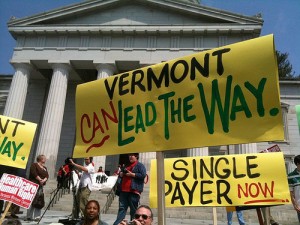 Regardless of how the Supreme Court rules on the constitutionality of President Obama’s health care law this summer, Vermont will move forward in creating the first single-payer health insurance system in the United States.
Regardless of how the Supreme Court rules on the constitutionality of President Obama’s health care law this summer, Vermont will move forward in creating the first single-payer health insurance system in the United States.
Under the system signed into law by Democrat Gov. Peter Shumlin in May 2011, a universal, taxpayer-financed government-managed system, Green Mountain Care, will replace private health insurance. All decisions about health care in the state will be made by a five-member, government-appointed board beginning in 2017.
Shumlin says he is determined to move forward with his plan regardless of the outcome at the Supreme Court and a possible removal of Obamacare subsidies.
“We’re going to reform this system with or without federal subsidies,” Shumlin said at a recent press conference.
Questions of Funding
Without federal funding, however, Vermont may not have enough people to support a single-payer system. According to Bruce Shields, president of the Ethan Allen Institute of Vermont, proponents have cited 1.5 million people as being necessary for a single-payer system to function, yet Vermont has a population of only 620,000—and even fewer will be in the system.
“Once you start going through ERISA exemptions, you find that about 50,000 cannot be covered by the Vermont plan. Then there is the teachers union, which represents about 10,000 people. They preferred the insurance they already had and decided not to participate in the Vermont plan. Lastly, the full-scale Medicare beneficiaries will be exempt,” said Shields. “So it begins to look like only half of the state could even apply for the Vermont plan.”
The administration, legislature, and board of Green Mountain Care have not released cost estimates or assumptions of how they will pay for the plan. Payroll, income, and sales tax increases are expected in order to cover the tab—but Shumlin has declined to reveal these costs until after Election Day, according to Sean Riley, a legislative analyst for the American Legislative Exchange Council.
“Vermont is alone in passing legislation signaling intent to pursue a single-payer model. And because Vermont’s single-payer law is largely silent on funding, benefits, and operation, we don’t know what the final product will look like,” Riley said.
Local Treasurer Calculates Cost
As no one no one connected with the implementation of Green Mountain was releasing calculated costs, Rutland City Treasurer Wendy Wilton decided to tackle the issue herself, computing the cost and sending a letter to every member of the legislature sharing her analysis.
Wilton found the single payer plan will result in a $300 million annual shortfall in the state’s $3 billion health care fund, culminating in a $2 billion cumulative deficit in five years. Green Mountain Care will also result in the largest tax increase in the history of Vermont, assuming a payroll tax is the primary funding option.
Wilton says no one has refuted or challenged her figures or offered an alternate payment model.
“It’s just a big shell game,” Wilton said. “The governor and the administration won’t criticize or refute my numbers because they don’t want to talk about it.”
If a significant payroll tax is levied in the Vermont economy, high wage employers and self-employed individuals may consider leaving the state, Wilton notes.
“The majority of Vermont’s legislators appear to want a single-payer, Canadian style health care system,” Wilton said. She advises other lawmakers tempted by the idea to “wait and see how this impacts Vermont before moving forward with any similar reform.”
Ending Private Insurance
Jeff Wennberg, executive director of Vermonters for Health Care Freedom, estimates 80,000 Vermonters will lose their health care coverage during the first year of the plan, since all people covered by association health plans will lose their private insurance coverage.
“The new law will basically outlaw private health insurance. It’s going to be a single-payer system, and the Green Mountain Care board will specify all the benefits. This is reckless and beyond belief,” Wennberg said.
“We don’t know if it will work or how it will function, who the providers will be, or what treatments will be covered. We probably won’t know the answers to any of these questions for another year. Yet the administration is so convinced that single-payer is the way to go and they’re untroubled by objections raised by people in the industry and businesses that they’re willing to march off a cliff and take 80,000 Vermonters with them,” he added.
May Have ‘Created a Monster’
Sally Pipes, president of the Pacific Research Institute, says Shumlin has committed Vermont to a system plagued with long wait times, limited access, and total government control.
“Once this train gets going down the track to single payer, it’s not certain how the state will pay for it. After all, Vermont is no hotbed of entrepreneurial activity, so when payroll taxes are implemented to pay for this system, and businesses leave, leaving fewer taxpayers to pick up the tab, you will see insurance premiums and taxes rise as more and more people get on government benefit programs, the same as in Canada and Great Britain,” said Pipes.
Wennberg says the legislature may ultimately regret taking an unsustainable path.
“They’re reforming every nook, corner, and cranny of health care in the state of Vermont. This will affect everything from doctor compensation to philosophy of health care to which treatments will be allowed. It is going to be a 100 percent government-controlled system. But now that they have single payer and ceded control to the Green Mountain Board, legislators are starting to wonder if they have created a monster,” says Wennberg.












